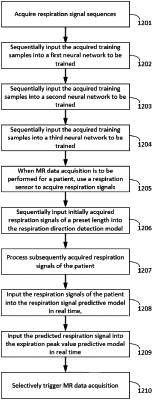| CPC A61B 5/7292 (2013.01) [A61B 5/055 (2013.01); A61B 5/0816 (2013.01); A61B 5/7267 (2013.01)] | 10 Claims |

|
1. A method for triggering magnetic resonance (MR) data acquisition, comprising:
acquiring respiration signals of (i) a same person or different persons during (ii) a same time period or different time periods;
sequentially inputting the acquired respiration signals as training samples to train a neural network such that an output of the neural network provides a correspondence between a respiration direction and amplitude variation of an inputted respiration signal to obtain a respiration direction detection model;
detecting a respiration direction of a subsequent respiration signal associated with an acquisition subject by inputting the subsequent respiration signal associated with the acquisition subject into the respiration direction detection model, and determining, according to an output of the respiration direction detection model, a correspondence between a respiration direction and amplitude variation of the subsequent respiration signal associated with the acquisition subject for each respiration period;
predicting, in real time, an amplitude peak value of an expiration signal in a current respiration period according to the subsequent respiration signal; and
when it is determined according to the respiration direction of the subsequent respiration signal that an expiration stage of the current respiration period is starting:
calculating, in real time or periodically, a product of a current expiration amplitude peak value and a predetermined coefficient to obtain a trigger point threshold of the current respiration period;
calculating an absolute value of a difference between the amplitude of the current expiration signal and the trigger point threshold of the current respiration period; and
when the absolute value of the difference is less than a predetermined difference threshold, triggering MR data acquisition.
|